Autism-Open Access
Open Access
ISSN: 2165-7890
ISSN: 2165-7890
Review Article - (2022)Volume 12, Issue 3
The year 2020 was marked by the worldwide pandemic caused by the Sars-Cov-2 virus, causing extra-ordinary contexts and bringing changes to people’s habits and lifestyles. People diagnosed with Autism Spectrum Disorder (ASD) had to introduce pervasive changes to their routines, re-adjusting the life context in which they had been placed. To respond to the situation, our organization, which uses the cognitive-behavioral Community Network Approach (CNA), had to extend its paradigm and to adapt to alternative forms of intervention, which could comply with the guidelines for the prevention and contrast of the spread of the virus. The CNA, which envisages the formulation of an individualized intervention plan that takes into account the person, their world and their life project, allows specific, recognized and valid aspects of other approaches to be integrated within it. To adapt its interventions to requirements, the CNA was inspired by the principles of Emotional Activation and Bodily Reciprocity therapy, integrating them with experiences of Outdoor Education and Schools on the Move and computer aids. This has enabled the following: the organization of a new routine, the preservation and implementation of friendships, the strengthening of social skills and the improvement of quality of life through the acquisition of greater flexibility.
Autism; Nature; Coronavirus; Emergency; Flexibility; Social skills; Learning
The COVID-19 pandemic further aggravated the living conditions of people with autism spectrum disorders. This text aims to disseminate a synthesis of our model developed over the years and applied during the pandemic. Our model has an integrated and ecological approach that responds, first of all, to the needs of autistic people, their families and their workers; but it also wants to be an answer for all those who want to live a satisfying, in symbiosis with the surrounding environment, the philosophy behind the well-being and happiness of each individual. Our analysis has always had as a starting point the study of: people with autism, environmental education, ecology, integration and social awareness of biodiversity. By the latter we mean the coexistence in the same ecosystem of different animal and plant species in equilibrium thanks to their reciprocal relationships, generating a wealth of infinite possibilities of life on earth thanks to biological variability: of genes, species, ecological niches and ecosystems. Over the past two years, isolation linked to the Covid-pandemic19 has aggravated the situation of people with autism and further complicated the life of the families who are facing the practical difficulties that living with this condition entails. To respond to the situation, our organization, which uses the cognitive-behavioral Community Network Approach (CNA), had to extend its paradigm and to adapt to alternative forms of intervention, which could comply with the guidelines for the prevention and contrast of the spread of the virus. To adapt its interventions to requirements, the CNA was inspired by the principles of Emotional Activation and Bodily Reciprocity therapy, integrating them with the CAA ( Augmentative and alternative communication), the TEACCH (Treatment and Education of Autistic and Related Communication Handicapped Children) and the experiences of Outdoor Education and Schools on the Move and computer aids. This has enabled the following: the organization of a new routine, the preservation and implementation of friendships, the strengthening of social skills and the improvement of quality of life through the acquisition of greater flexibility.
The community network approach
The pandemic resulting from the spread of the Sars-CoV-2 virus has led to extraordinary contexts, in which lifestyles and personal habits have had to adapt to the change. This has led therapists and other professionals working with frail people to think of new ways to respond to the needs of people they care for.
Tutti giù per Terra, a Social Cooperative of Rome, adopts the Community Network Approach (CNA) and it had to cope with the emergency by extending its paradigm and adapting to alternative forms of intervention, which would conform to the guidelines for the prevention and contrast of the spread of the virus.
Ours is a flexible approach, which involves the formulation of an individualized intervention plan that takes into account the person, his world and his life project and which includes the possibility of integrating specific, recognized and valid aspects of other approaches [1].
The core of the enabling intervention are the principles of emotional activation and bodily reciprocity [2,3] which focus on the relationship and emotional attunement with the assisted to create a bond of trust that leads to collaboration. This cooperation is achieved through an emotionally connected guided activity, that denotes a deep acceptance of the other and that supports him/her in the experimentation of new adaptive strategies. The CNA also sees, among its primary objectives, the increase of communication skills (verbal and non-verbal), social skills and the strengthening of autonomy, functional to improve the sense of self-effectiveness of each one. The approach is therefore based on personal development skills, the interests of the person and her qualities, with an attention to sensory integration, necessary to support individualized growth [4-6]. Among its working tools, the CNA also uses materials from the Kids' Workshops, inspired by Native American worldview [7,8].
The point of reference of the CNA is, therefore, the cognitivebehavioural integrated one (Treatment and Education of Autistic and Related Communication Handicapped Children-TEACCH), with the help of specific learning and communication materials, such as: CAA, PECS, Shoebox tasks and other IT supports [9-11].
An aid that, in the experience of the CNA, has demonstrated its considerable value is the Augmentative and Alternative Communication (CAA), which consists on a set of tools and strategies employable by people with verbal difficulties functional to overcome everyday communication challenges. One of the CNA’s actions is the CAA’s training of schoolchildren and children who do activities with us (summer camps, outdoor education), functional to integrate people with verbal difficulties. The adoption of TEACCH program allowed us to pay particular attention to structuring the environment in order to strengthen independence.
TEACCH, as pointed out, is not a method, but a state program, conceived and designed by Eric Schopler in the sixties and put at service of the autistic population of North Carolina [12]. Its aim is to promote independence and autonomy of persons with autism spectrum diagnoses, stimulating emerging abilities in the individual through an adaptation of the surrounding environment [13].
It is a continuous and coordinated intervention, structured to facilitate the integration of the autistic person into society, from an early age to adulthood [14].
TEACCH programme provides, in particular, the introduction, in the environment, of a series of facilities that can respond to the autistic person’s needs [15,16].
How we handled the emergency
Our focused on the needs approach allowed us, as a result of the state of emergency, to test new tools of work and adapt the interventions to the needs, taking inspiration by the outdoor education and the school in motion [17].
This unexpected turn of events has therefore enabled the CNA to exploit the possibility that the new scenario offered and evolve towards new horizons. This situation has imposed the rethinking of the usual ways of interaction with people, offering the opportunity to seek new and innovative solutions. The greater challenge has been to remodulate the activities of our three main projects: ABC Autismo, Accademia degli Autismi e Progetto Ponte Arcobaleno. All three projects usually take place at the ASD La Collina Storta, a green space where disabled children, appropriately trained and followed, are at the center of the organization of services. La Collina Storta has taken shape, even at an architectural level, from outdoor schools, built in the early years of the twentieth century to limit the contagion of tuberculosis [18]. The Center is an open space, surrounded by greenery, with several workstations and relaxation areas, designed to accommodate people with autism spectrum diagnosis, through facilitations visual and sensory (Figure 1).
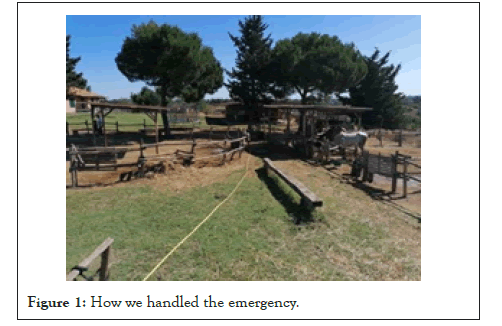
Figure 1: How we handled the emergency.
Green spaces are configured as an integrated aggregation centre with a psycho-educational, technological, ecological, high social value approach. For example, one of the main elements of the CNA is the sensory integration work Ayres Sensory Integration- ASI [19]. Sensory integration means a neurobiological process responsible for the organization of the sensations coming from the body and the surrounding environment, which allows us to use them in a functional way, interpreting, associating and unifying them to respond adaptively to the context.
Performing outdoor therapies allows us to work on strengthening areas of development through the stimulation of the senses by animals, various natural surfaces and the aromatic garden, cared for and managed by the kids themselves. The sensory room, an area furnished with materials that promote relaxation and emotional self-regulation, has been moved to the barn, valuing all the elements that space offers us.
The different animals of La Collina Storta represent an important emotional activation stimulus, which spurs children and young people to an active collaboration: taking care of animals and spaces becomes a reason of pride, leading to a feeling of greater self-effectiveness and making identify the kids with the role of volunteers of La Collina Storta.
Cheerfulness, surprise, curiosity and humor are also the basis of the taking over of the Community Network Approach. We try, daily, to create a path of common growth, also including the most fragile workers: a space that welcomes and supports, with the aim of creating a supportive group that together walks towards new goals. Our goal is to form mixed groups of people with shared values that together take a new path to communicate and share life experiences.
The beauty of nature, animals and people who have chosen to attend the spaces of La Collina Storta are fundamental ingredients to generate a perspective change: the diversity turns, for us, into an opportunity to grow and discover new frontiers, not yet explored, of our approach.
We share a life path, enhancing the strengths of the group and exalting each of us’ talents and predispositions to obtain a precious result: demonstrate that, despite differences and special needs, our young people work to contribute to the beauty of the space, respecting nature and animals and with a great desire to socialize and have fun. Volunteers at La Collina Storta can actively contribute to improve space and activities. People often come, donate a new bench, plant a tree or provide us with functional elements to our activities.
Everyone tries, with its own means, to do something to preserve and improve this beautiful shared space. The three projects usually carried out at La Collina Storta and realized thanks to the contribution of the Unione Buddhista Italiana, divided by age, are:
• ABC Autism
• Academy of Autism
• Rainbow Bridge Accademia
ABC Autism involves eight children with Autistic Spectrum Disorder diagnosis and it takes place in the open air. Aimed at parents and children from 2 to 5 years, ABC is based on therapy mediated by parents, which provides training on AERC principles and Augmentative Alternative and Communication, the use of social histories and the TEACCH approach, all fundamental tools to build a relationship with atypical children. This project provides parenting support, animals assisted activities, sensory laboratory and parental mediated therapy (Figure 2).
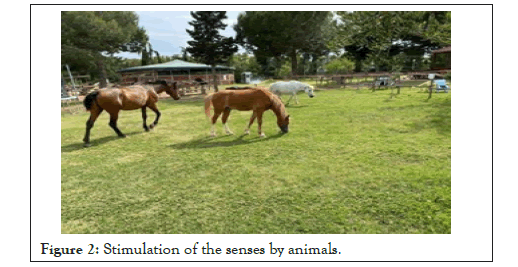
Figure 2: Stimulation of the senses by animals.
Parents and children come to La Collina Storta respecting, together with the team (Psychotherapist, occupational therapist, educator, animal helper, IAA contact person), a rotating spacetime organization and maintaining the individualized program, networking with ASL and schools (Figure 3).
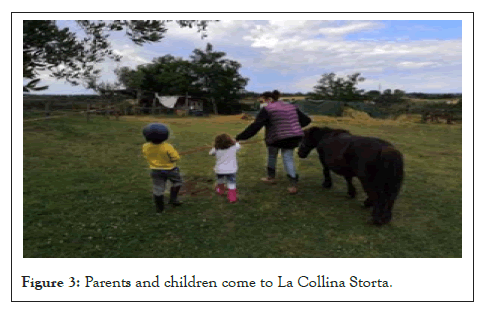
Figure 3: Parents and children come to La Collina Storta.
Academy of Autism is addressed to minors divided in age groups, and sees the organization of various workshops (yoga, theater, fitness, cooking, etc.), designed and structured to facilitate communication, stimulating socialization. The main role is covered by the use of a TEACCH visual activity program, suitable aids and tools (Shoebox Tasks, CAA, etc.) and Animal Assisted Intervention (AAI).
Rainbow Bridge Accademia involves nine young people aged 18 and over, and takes care of the transition from the post-school period to adult life. Through accompaniment of a multidisciplinary team, young people follow a path aimed at the acquisition of autonomy, structured to achieve the acquisition of skills and useful attitudes to maximize their independence and encourage them in personal awareness.
Main challenges
The rise of the pandemic has brought with it enormous management challenges, starting from the Prime Minister Giuseppe Conte’s announcement on 11th March 2020.
When the announcement came, in fact, an integrated group of kids and health workers were located outside Rome for a recreational stay for the acquisition of autonomy (Figure 4).
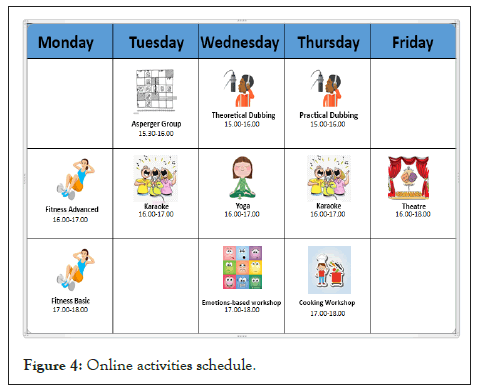
Figure 4: Online activities schedule.
The news has seen the whole group engaged in the prompt management of the emergency. The kids themselves, involved in the change of organization, have shown great flexibility and understanding of the situation, receiving, even if at a distance, great support from the family network.
From this initial stage of containment, and during the next confinement, it was necessary to re-think all the services and remodulate the work of the entire team with the aim of reaching the expected results through online activities and by the use of technological platforms.
Our attitude has always been optimistic: we were aware of the work carried out over the years with the children and their families (such as the parent coaching and we believed that the most of them would react well to changes [20].
This, however, required great flexibility and involvement of family members, with the technical support of our staff for the management of the technological platforms.
In fact, as stated by Wrobel, it is necessary to work closely, in collaboration with parents, to establish routine and promote the maximum level of autonomy at home [21].
Online workshops
All the laboratories, usually attended in presence, have been remodulated online. The new technologies are, moreover, an integral part of our everyday life, and this occasion allowed us to employ their countless features, using them as valuable tools of remote intervention and adding them to our approach.
The first activity remodulated was the physical one, necessary to free the excess energies accumulated during the isolation. The idea was, therefore, to create a sequence of motor exercises, visually organized with the help of the CAA.
The finish experience of «schools on the move» has shown that learning improves if children alternate sedentary moments to moments of physical activity. It has been found that students who took part in motor activities then obtained better results in memory tasks than control group [22].
Not only, it has been demonstrated that physical activity also implements executive functions attention and academic achievement in general (Figure 5) [23,24].
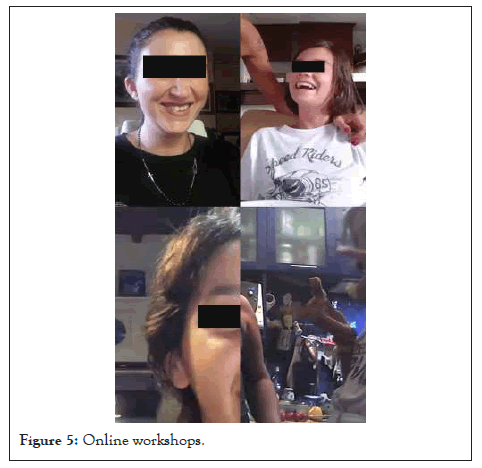
Figure 5: Online workshops.
The yoga workshop was effective as it was set on self-regulation and on exercises useful to body knowledge and breathe regulation. This activity was accompanied by emotions-based workshop, aimed at increasing self-awareness by intervening, for example, on anxiety [25,26]. The laboratory was developed thanks to the addition of a series of movements, useful for enhancing imitation and through the support of images and scheme of activities divided into lists [27,28].
Another online laboratory, already active for years and very important in this delicate moment of social isolation, was the theatre workshop. The theatrical activity works on social adaptability and on the expression of the self through singing or dancing [29]. The cooking workshop, on the other hand, allowed the kids and their families to continue working remotely on: respect of the rules, increase of responsibility, personal autonomy, motor skills and, above all, socialization and self-esteem [30]. To complete the weekly routine, we added a recreational karaoke workshop with CAA tools and division into phases of the action, a much-appreciated activity.
During the lockdown we added two new workshops: the dubbing workshop was proposed by the kids themselves and it was based on their common passion. The activity was divided into two parts: the theoretical one, with the study of the basics of acting and diction through the use of CAA, and the practical one in which, through the use of specific apps, the guys got involved in dubbing videos. Another workshop was the one dedicated to kids with Asperger's syndrome: considering their usual resistance to socializing, we have "exploited" the habit to connect to create a group in which proposing fun activities, stimulating their sense of belonging, implementing the social skills and developing emotional reciprocity (Figure 6).
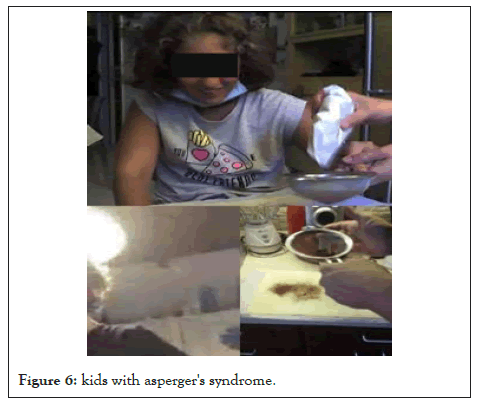
Figure 6: kids with asperger's syndrome.
For the youngster of «Progetto Ponte Arcobaleno», young adults who constitute now a close-knit group, it was important to keep in touch with friends and operators. For this reason, we have organized social aperitifs: every Saturday, at 6pm, we would connect via Zoom to spend together some time, support social skills and strengthen friendships. This appointment allowed us to continue our work on domestic autonomy, good manners, and socialization e conversational rules. In fact, everyone had to preventively choose what to eat and drink during the aperitif and prepare it, when necessary, with the help of visual aids [31].
The aperitif was always structured in the same way: everyone waited for the whole group to be online, working on tolerance and waiting, and they tried to respect all those conversational rules acquired during the year, like maintaining the eye contact, waiting for them conversational turn, listening to the other. Then, each one showed to the others what he had to eat and ate, establishing shifts in which each one shared the making of his plate using visual material. The final part was dedicated to the free choice of topics and the sharing of events or anniversaries, such as April 25, in which we talked about the liberation and his meaning, through the use of visual schemes (Figure 7).
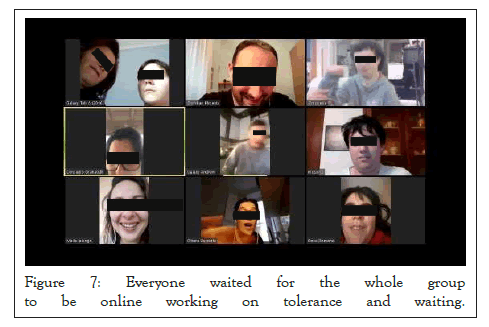
Figure 7: Everyone waited for the whole group to be online working on tolerance and waiting.
The goal of these meetings was to face the difficult period together and allow emotional exchange, offering age-appropriate social opportunities.
The intervention of the parents was, in fact, reduced to the phase of greeting: an opportunity, also for them, to meet again.
New routines
People diagnosed with autistic spectrum respond positively to routines, and this can be used advantageously and incorporated into the activities structure [32]. To facilitate children and parents, all workshops have been scheduled to create a weekly habit: every day, at the same time, the kids had to connect from the same room in the house, using the same PC and the same access codes. As for the aperitifs, having fixed appointment and structured conversation times allowed the kids to lower levels of anxiety. The shifts, initially regulated by an operator acting as a mediator, were then run by the kids themselves.
The importance of sociality
The use of digital platforms allowed young people who during the time lost contact with the group to return to be part of it. Furthermore, thanks to the online workshops, even people coming from other areas of Europe actively participated at the meetings. As for everyone, in fact, the period of isolation involved a loss of sociability. The risk that this phase of de-socialization was internalized was high. The boys needed friends: this was the reason which prompted us to proceed with the organization of the workshops.
Strengths and challenges of online activities
The workshops’ participation was numerous and engaging: the kids got good results while having a lot of fun. Especially the ones less prone to interaction benefited from this modality. As for the online aperitif initiative, we found initial resistances by some kids who have had a hard time incorporate this activity into their daily routine, but repeated patterns routine allowed them to participate in all meetings.
Another challenge arose from the relationship with the technological device, from the familiarization with the screen and the direction of the gaze. The distance has sometimes created confusion in the implementation of skills previously acquired, due to the physical absence of the group. Despite some difficulties, the benefits were a lot, and Saturday aperitifs and the other workshops have become events awaited with joy by all.
Our guys, operators and trainees of “La Collina Storta” are used to share many hours a day in the same place, to laugh together and to work hard sharing places and materials. They therefore needed to find their sphere of sharing. We also noticed a great deal of participation during the summer, when the kids also connected from the holidays: we have therefore decided to integrate this new formula inside of traditional proposals. In addition to the remodelling of the training and recreational laboratories for children, it was necessary to provide a space for listening and discussion for parents and children operators, through remote psychological support (parent training online): a psychologist collaborated in the management of the emergency, offering support in the creation of routines and in the use of visual aids, such as social stories and comic strip conversations, which have proven to be effective tools for children's understanding of the situation. Comics in particular, argue [33], systematically identify what people say and do. Each comic considers, in interactions, thoughts and feelings as having the same importance of words and actions; it also provides insights into it to the perspective of the subject of a situation, serving as an excellent prerequisite for the development of social histories. Supporting the families of the children was, especially in this period, essential.
In fact, as Ianes and Cramerotti underline “building a meaningful alliance with these parents is perhaps one of the most difficult tasks” and the priority of the CNA was not to lose the work done over the years and to strengthen its support network so that parents do not feel abandoned [34]. As the authors suggest, citing the Webster- Stratton text, we applied the collaborative model to work with the parents of children presenting problem behaviours: “working collaboratively with parents may require a number of strategic tasks: building a strong supportive relationship, create a sense of self-affirmation, teach, interpret, guide, question and hypothesize" [35,36]. This is precisely the point of view of the Community and Network Approach.
Other remodelled activities were: supervision, equip meetings, GLOs, psychotherapies, support for teachers and fragile parenting, which have been integrated with stimuli for the proper conduct of remote teaching, through the selection of the most suitable materials to enhance the attention capacity of the children and their collaboration. At the same time, we provided continuity in the care of children with specific learning disorders and with particular needs in carrying out school activities.
The coexistence of remote and face-to-face activities
In May we resumed some of our usual activities, having to make several changes to the environment of "La Collina Storta" to adapt to the contagion prevention measures, guaranteeing distancing, adopting the protective devices and modifying the relationship with the operator in 1: 1. The numerous researches that have involved the outdoor school in recent years (outdoor education) confirmed the positive effects of this methodology on the psychophysical, emotional and cognitive development of the child. Through a sensory- experiential learning, it has been shown that the outdoors education improves social and problem- solving skills, motor skills, linguistic and collaborative capacities, as well as fostering greater awareness towards ecology (Figure 8) [37].
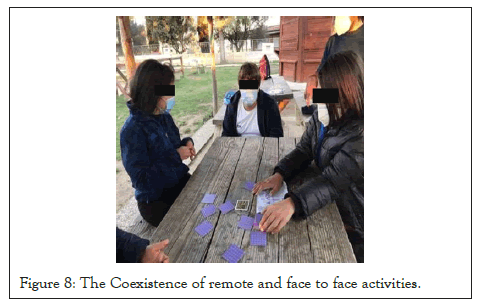
Figure 8: The Coexistence of remote and face to face activities.
The multisensory open spaces of La Collina Storta immediately appeared suitable to be structured in order to meet both the needs of distancing imposed by the ongoing pandemic, and the needs of children with Autistic Spectrum Disorder. They need an organized work environment, organized in clearly and visually delimited spaces, within the perspective of the TEACCH approach, which enhances the usefulness of structured strategies to reduce discomfort and confusion and support the children in obtaining the highest levels of independence [38].
Structural modifications
The spaces of “La Collina Storta” have been redesigned on the basis of the planned activities (the yoga area, the theatre area, etc.). The environment has been structured outdoors by providing suitable stations to accommodate groups of three children and respecting the rules of distancing, sanitizing the materials and teaching the kids to do it themselves, reviewing the duration times of each activity, the materials and resources used. Consistently with the predilection of autistic people for the visual channel and considering the effectiveness of the visual instructions, the strategy used to ensure that the rules of social distancing was to mark with an X the place that each kid would have to occupy and put above each place the hygiene rules to follow, the visual agendas of the day and the rules of conduct [39,40]. Small groups were formed by further dividing children, teenagers and young adults according to the levels of functioning. As a precaution it was decided not to let the various groups come into contact with each other [41-43]. Each station was also equipped with a canopy, so we could continue to carry out outdoor activities even in case of bad weather. The surrounding environment was a potential source of distraction transformed into a source of countless learning stimuli [44-46].
Outdoor therapy
The first work concerned the use of face masks, hand washing and spacing. It was necessary a series of guided learning phases, which then became habits as we worked at the same time on changes in the structure of the environment and on new rules (Figure 9).
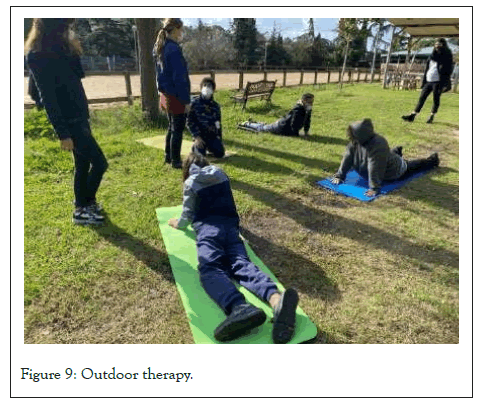
Figure 9: Outdoor therapy.
.To facilitate the inclusion of these new practices we used social stories and video modelling, a technique that, through the use of technological supports, promotes the acquisition of social skills in children and teenagers [47,48]. It was also necessary to transfer this vision to parents and operators, training them on the potential of remodelling. It was therefore explained to them the importance of dressing children appropriately [49-51].
It was necessary to work with the autistic kids on the predictability of the organizational innovations they would find in their return to “La Collina Storta” [52-54]. Each parent was provided with a social history, to read with their kids before returning, explaining why, with coronavirus, a series of changes were needed, not just structural but also regulatory. Thanks to this work, the boys have transferred the usual activity scheme, already consolidated, in the new open spaces and with the new modalities, enriching it, however, with the potential that materials present in nature offer [55-57].
The afternoon activity of the "Academy of Autisms", for example, begins with an outdoor yoga session, which helps kids find the right setting before the start of activities. In addition to the classic individual work, done at the table, on emerging skills, we decided to increase occupational activities, such as feeding the animals of "La Collina Storta" or collecting leaves with a rake, which have become opportunities to work on autonomies and on different cognitive skills in a highly motivating context for the child. From this point of view, the pebbles have become a useful tool to learn how to associate the number to the quantity, the flowers to work on the recognition of colours, and soon Street. The result was a considerable increase of self-esteem (Figure 10) [58-61].
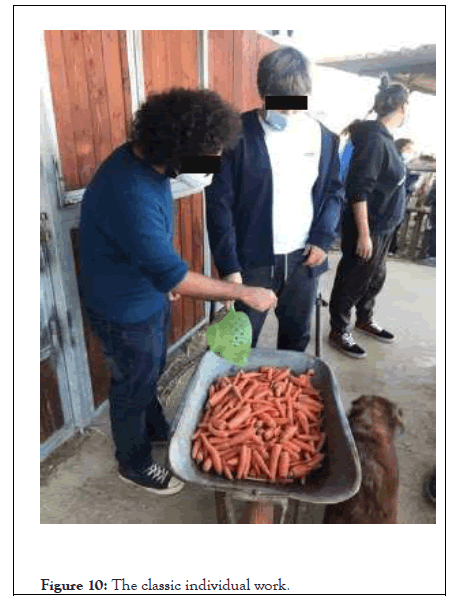
Figure 10: The classic individual work.
The method of intervention of the Community and Network Approach also sees the centrality of j fun: learning in a stimulating and pleasant environment is easier and leads to better results both in the short and in the medium and long term [62]. Our priority has always been for children and young people to have fun and feel well. In this period of limitations, distances, privations and negative emotions, it was more necessary to intensify this appearance [63,64]. For example, the working week of the “Accademia degli Autismi”, usually ends with the theater workshop: a laboratory including dancing, singing and self-expression. Given the restrictions, we had to remodel the workshop dividing the children into very small groups (Figure 11) [65-67].
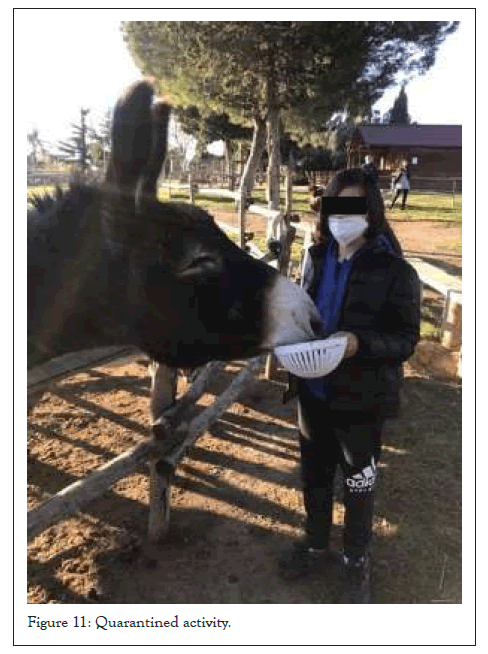
Figure 11: Quarantined activity.
We have had cases of fiduciary quarantine and, in these situations; the experience acquired during the lockdown was useful to provide continuity to the work [68]. Through the creation of specific social stories, we explained to the children the reasons of the isolation and the importance of respecting the quarantine [69]. Despite the state of quarantine, the activities continued. For example, the big boys of "Progetto Arcobaleno" manage a sorting activity of vegetable crates at “La Collina Storta”. Each one of them, according to their peculiarities, has a role: who is in charge of answering the phone to receive orders, who transcribes the data on the PC, who sorts the vegetables, who delivers, who manages the donations and so on [70,71].
For a while the guy responsible of the phone calls was at home in quarantine, but thanks to his familiarity with technological features, he succeeded to carry on the smart working activity: a fundamental solution not to lose the rhythm and for his self-esteem. The great opportunity gained in recent months is the acquisition of a new flexibility and the incorporation of new technologies to our approach. The changes introduced have allowed the children to carry on their evolutionary path, and the Community Network Approach-CNA) to enrich itself and make the limits imposed by the period its new strengths.
[Crossref] [Google Scholar] [PubMed]
[Crossref] [Google Scholar] [PubMed]
[Crossref] [Google Scholar] [PubMed]
[CrossRef] [Google Scholar]
[Crossref] [Google Scholar] [PubMed]
[Crossref] [Google Scholar] [PubMed]
[Google Scholar] [PubMed]
[Crossref] [Google Scholar] [PubMed]
[Crossref] [Google Scholar] [PubMed]
[Crossref] [Google Scholar] [PubMed]
[CrossRef] [Google Scholar] [PubMed]
[Crossref] [Google Scholar] [PubMed]
[Google Scholar] [PubMed]
[Crossref] [Google Scholar] [PubMed]
[Crossref] [Google Scholar] [PubMed]
[Crossref] [Google Scholar] [PubMed]
Citation: Sonnino F, Granatelli C, Nazzicone S, Ferrante F, Surini C, Baffetti S (2022) Autism in the Age of Coronavirus: How the Community Network Approach (CNA) Handled the Emergency. Autism Open Access. 12:308.
Received: 21-Mar-2022, Manuscript No. AUO-22-16329; Editor assigned: 25-Mar-2022, Pre QC No. AUO-22-16329 (PQ); Reviewed: 08-Apr-2022, QC No. AUO-22-16329; Revised: 15-Apr-2022, Manuscript No. AUO-22-16329 (R); Published: 22-Apr-2022 , DOI: 10.35248/2165-7890.22.12.308
Copyright: © 2022 Sonnino F, et al. This is an open-access article distributed under the terms of the Creative Commons Attribution License, which permits unrestricted use, distribution, and reproduction in any medium, provided the original author and source are credited.